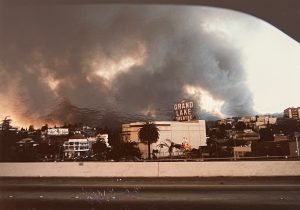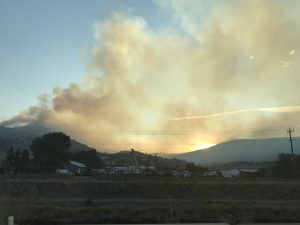
Smoke over Osoyoos
The 49er’s game was on TV and the strangest thing—black smoke was drifting into Candlestick Park from the East Bay. It was October 20 1991, and we were having a lazy Sunday morning following a weekend spent with friends in Sonoma County celebrating 10 years of being “together”. If you know the Bay Area microclimates, you know that the winds blow from west to east, often bringing in the famous San Francisco fog, so the black smoke was immediately intuited as “wrong”. The announcers said it was from a fire in the East Bay Hills; the wind pushing west was our version of the dreaded dry Santa Ana winds whipping the hot Central Valley air back into the Bay. Our morning was cut short as we all gathered up our things and headed home.
The fire was blowing along the ridgeline in our direction. Trees were candling—igniting and throwing off firebrands--burning hunks of wood. Now the fire had jumped the vast concrete firebreak of Hwy 24 into the Oakland Hills.
Driving south toward Oakland, we could see the line of smoke well, and once we got onto I-580, it was clearly coming from the hills above the Berkeley/Oakland border. We had the car radio going and turned on the TV when we got home, listening for the evacuation and alert messages. The fire was blowing along the ridgeline in our direction. Trees were candling—igniting and throwing off firebrands–burning hunks of wood. Now the fire had jumped the vast concrete firebreak of Hwy 24 into the Oakland Hills. Stories spread of cars caught on the narrow winding roads, harrowing escapes and missing people. The evacuations extended to Park Blvd, close to our house.
We packed our car. How do you decide what to save? Photos, passports, pets, a few clothes. No cloud backup in those days. Take pictures of the house to document what we had before it was incinerated. Wait for the call to leave. Look anxiously at the red glow on the horizon throughout the night, hoping for a shift in the wind.
The weather turned and we were spared, but 25 people lost their lives. 2,843 houses gone. 1,520 acres burned. Started by a grass fire incompletely extinguished. The devastated area was nothing but gray ash—houses, cars, trees all gone. Only the odd brick chimney or foundation remained. The following spring, daffodils sprang up where garden paths used to be as if part of a macabre funeral offering.
Houses were rebuilt and thirty-plus years later the only sign of the fire is the memorial to the dead outside Hiller Highlands, which got the first and worst of the storm. It was reportedly one of those rare sporadic tragedies. But I had learned to fear October and the fire wind, as I came to call it. When the hot dry air blew in from the east, I was tense and uneasy until the fog returned. We made note of the escape routes in our area, the roofing materials. The earthquake “go bag” served double duty as an all-purpose evacuation kit.
When we moved to Canada, it was to the dry Ponderosa pine country of inland BC that reminded us of Northern California. “Napa Valley with Lake Tahoe down the middle”. It was the year after the 2003 Okanagan Mountain Park fire. Lightning strike. 239 houses gone, 25,912 acres burned. Our new house had a perfect view of the burned mountain. We were still in fire country.
Since then, fire has increasingly ravaged the Western US and Canada, Australia, Greece, Siberia, Hawaii and other less-well reported parts of the world. In 2021 the heat dome in the Pacific Northwest caused over 600 human deaths and untold marine creature deaths in Vancouver; the town of Lytton burned to the ground in unprecedented over-100 F temperatures. The average temperature of the world is approaching 1.5 C above historical levels and is predicted to go higher; July 2023 was the hottest month ever recorded. Smoke has spread over New York, Chicago, San Francisco and vast areas of the North American continent. Last week Lahaina was obliterated in a firestorm when a distant hurricane whipped up drought-dry winds. This week the town of Enterprise was incinerated in the Northwest Territories and now the 20,000 people of Yellowknife are being evacuated, More will have happened by the time you read this.
In my town we have had red sun in the smoke every summer for years, now better known as “fire season”. Fires have been repeatedly visible from my house. Evacuations and alerts are commonplace. Call *5555 to report a fire, check your fire-tracking apps, make your home “FireSmart”. The skies have filled with water bombers, fire-retardant bombers, helicopters dragging water buckets, synchronized skimmer planes that suck up water from the lakes and drop their load one after the other over their target. Remote fires burn until the weather changes.
This year, the worst fire year in Canada ever, we have had record heat, up to almost 100F this week where I live. The air is gray–it had been due to smoke from the giant Eagle Bluffs wildfire that crossed from Washington State near Osoyoos, but now two fires have merged in the mountains behind Keremeos creating pyrocumulus clouds so it is probably from that. Could also be from West Kelowna (800 houses under evacuation for now), or even the Shuswap, Kamloops or Revelstoke fire smoke drifting south. Or something new? It changes as I write.
Emergency systems are having to move to permanent readiness. Memorials for firefighters killed in the line of duty are increasingly common.
And prevention? There is so much that could be done, all outlined in governmental reports and international agreements. We could heed them. Meanwhile, people get ready. The fire next time is here.












Khati, a chilling story from that first encounter back in your CA days, to up-to-the minute reporting. You are living in harrowing times, my friend, but in a way, we all are (whether we are in the path of fire, flooding, torrential rains, or whatever the forces of climate change has in store for us). You are right, much could be done (I just read an article about water management in the Maui area that might have helped but was too little, too late). Perhaps now the world will wake up.
Yes, whether it be fire or flood or tornado or drought or heat dome or deep freeze that is “unprecedented” affecting your area, or you are just paying attention to the rest of the world, there are ample opportunities for wake-up calls, many lessons to learn, and so much to do. Welcome to climate change.
We thought about similar things when we associated to the prompt “fire.” Climate change has made these fires bigger and more common. I have often wondered what I would take if I had to evacuate my home. I’m still not sure.
Yes, I thought the same thing when I read your post. I think a lot of people will be thinking about similar things too, unfortunately.
Thanx Khati for reminding us of more inconvenient truths about our environmental crises – and too many warnings unheeded.
How terrifying when devastation hits so close to home.
As if we needed more reminders. But there it is.
Such a sad depiction of a world on fire. We, on the eastern seaboard of the United States are currently spared from this summer’s extreme temps. Reading your story opened my eyes to the horrifying prospect of the “rare sporadic tragedies”. Although all your experiences are definitely unfamiliar to me in my location in Jersey. Further south is where the threat is. This piece was so well-written Khati, I felt the heat, saw the winds blowing the flames, that alarming red sun. Sadness for nature, the scorching earth swallowing those trees, the flowers, everything in its path. It’s so hard living in a world where half the population is so easily manipulated and selfishly blind. We must take action now.
I think quite a few people were surprised when the smoke from the north blanketed the Northeast, and when the day is lovely around you it is hard to imagine it could be otherwise. For me, I don’t see hurricanes or tornadoes but know they wreak havoc elsewhere. Whatever the flavor of climate change in your home, it is opening eyes more and more.